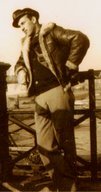
|

|
|
|
|
One of five children, James was born to John William and Rose Gardener Larkin in St. Paul, Minnesota. John, an immigrant from Ireland, was captain of the fire department and a veteran of the Spanish-American War. With his earliest memory of Charles Lindbergh completing the world's first transatlantic solo flight, James' future was headed into the sky. Graduating from Washington High School in 1940, he joined the U.S. Army Air Forces on February 13, 1942, and was sent in June to basic training at Santa Ana, California. There he volunteered to be a glider pilot and was sent to Pittsburg, Kansas, for primary glider training. He took both basic and advanced glider training South Plains Army Air Field in Lubbock, Texas, where he learned to fly homemade gliders. In advanced training, he flew CG-4As, and graduated February 4, 1943. His class, 43-3, was the third class to finish the training. James also cross-trained as a co-pilot on C-47s. Newly commissioned as a flight officer, he was sent to Oklahoma's Ardmore Army Airbase for ground training, in which he learned how to survive how to in combat zones. After more ground training at Bowman Field in Louisville, Kentucky, he trained in CG-4As at Maxton Army Air Base in Laurinburg, North Carolina. In September of 1943 he joined the 84th Troop Carrier Squadron, part of the 437th Air Group. He was sent to Fort Wayne, Indiana, in December of 1943 for processing overseas. In January of 1944 he sailed on the RMS Mauretania to Liverpool, and then was stationed at Ramsbury in County Wiltshire. Their training, including physical exercises, continued until June 6. "I trained for two solid years for one mission," he says. Ten days before D-Day, he participated in a dress rehearsal with the 82nd and 101st Airborne Divisions. Then, he flew troops of the 82nd into Normandy in the early morning of June 6, when he landed in a meadow, breaking one wing on a concrete pole and spinning around. But his "cargo" aboard was safe--an anti-tank gun, three soldiers and his co-pilot. Afoot for several days, James was able to return to the beach at Normandy, where he was flown back to England in a C-47. In the invasion of southern France in August of 1944 he carried Japanese-American troops to battle. The next month he flew into Holland on the first day of Operation Market Garden. From that fall into early 1945 he ferried gasoline supplies in C-47s from England into France, returning with wounded. His next glider mission came on March 25, 1945 when his unit flew the 17th Airborne Division into Germany. After victory in Europe, he returned to America on a Liberty ship, received thirty days' leave, and was told to report to San Francisco for the planned invasion of Japan. Had the invasion occurred, he believes he had no chance of survival. On August 9, 1945, he married Arshula Washburn, a girl he had met in high school, in the chapel at Fort Snelling, Minnesota. After the war he served at various bases, including Barksdale Air Force Base, where he flew B-17s and was rated for engines. He left the service on June 30, 1946 as a first lieutenant and with a reserve commission. He opened a business in Bossier City, Madden and Larkin, a planning and development company in home building, where he spent the rest of his career. |


